Every modern non-governmental organizations (NGO) has adopted the internet as its main tool for outreach and communication. It's fairly easy to see why. This is where they can find many supporters with relatively low effort.
Their first step in the digital space usually takes place on social media platforms. After all, people spend a lot of time there, so it's easy to get noticed. Yet, Facebook, Instagram, and other social media platforms do not provide non-governmental organizations with the full scope needed to engage and inform their audience.
A well-designed nonprofit website can fulfill this need. It offers an unlimited canvas for detailed content, donation options, and many more features. But what makes an effective website for an NGO?
Here's everything you need to know about nonprofit website design and selecting the right web designers to bring it to life.
What Is an NGO?
An NGO is an independent group that work to address social or political issues. They operate without government control, relying on donations and volunteers to function. NGOs tackle a wide range of causes, from environmental protection to human rights advocacy.
While many assume all NGOs are nonprofits, this isn’t always the case. Some NGOs do generate income through various activities, like selling merchandise or offering paid services. But unlike businesses, their main aim isn’t to make money, but to help others and make things better.
As such, developing and maintaining a complex website may appear as an inconsequential expense. However, the website reflects the organization's mission to attract visitors, potential supporters, and donors by effectively communicating the organization's values and initiatives.
This is true to some degree. Of course, an NGO should not spend too much money on their website. At the same time, a well-designed website is much more than a digital brochure. Here’s how it can help your nonprofit organization:
- Increasing visibility. A solid website helps your NGO stand out in a crowded online space and make it easier for potential supporters to find and learn about their cause.
- Building credibility. An informative website lends legitimacy to an NGO, showcasing its authority and commitment to its mission.
- Encouraging engagement. Interactive features and regular updates encourage visitors to engage with your NGO, fostering a sense of community and involvement.
- Increasing interest and donations. Clear calls-to-action and user-friendly donation processes can boost your NGO's fundraising efforts and volunteer recruitment.
These aspects only scratch the surface of what effective NGO website design can achieve. Just like with any other niche, positive user experience means a lot for achieving the organization's mission.
Key Elements of a Great NGO Website
Now that we understand the importance of a well-designed nonprofit website, let's dive into what makes one truly effective. Here's a summary of our analysis of the best nonprofit websites.
Clear Mission and Storytelling
A clear mission statement that resonates with the organization's mission is the starting point for a good nonprofit website design. You can’t educate visitors about the cause and your organization’s commitment if they can’t immediately say what it is.
On one hand, this is something all NGO websites do, at least to a certain degree. On the other, this is what separates average and top nonprofit websites. Clear mission statement helps website visitors understand why your NGO is necessary and feel motivated to get involved.
KidSport Canada is a good example of this. Their website tells the nonprofit’s story through the lens of the kids they help. In other words, it uses short videos of their pupils to show what the NGO does and how you can help.
This way, KidSport creates emotional connections with website visitors. They don’t just tell what they do as a nonprofit. They show individual kids they’ve helped and tell how their lives have changed. Giving a face to your nonprofit’s mission is a very effective way to engage visitors.
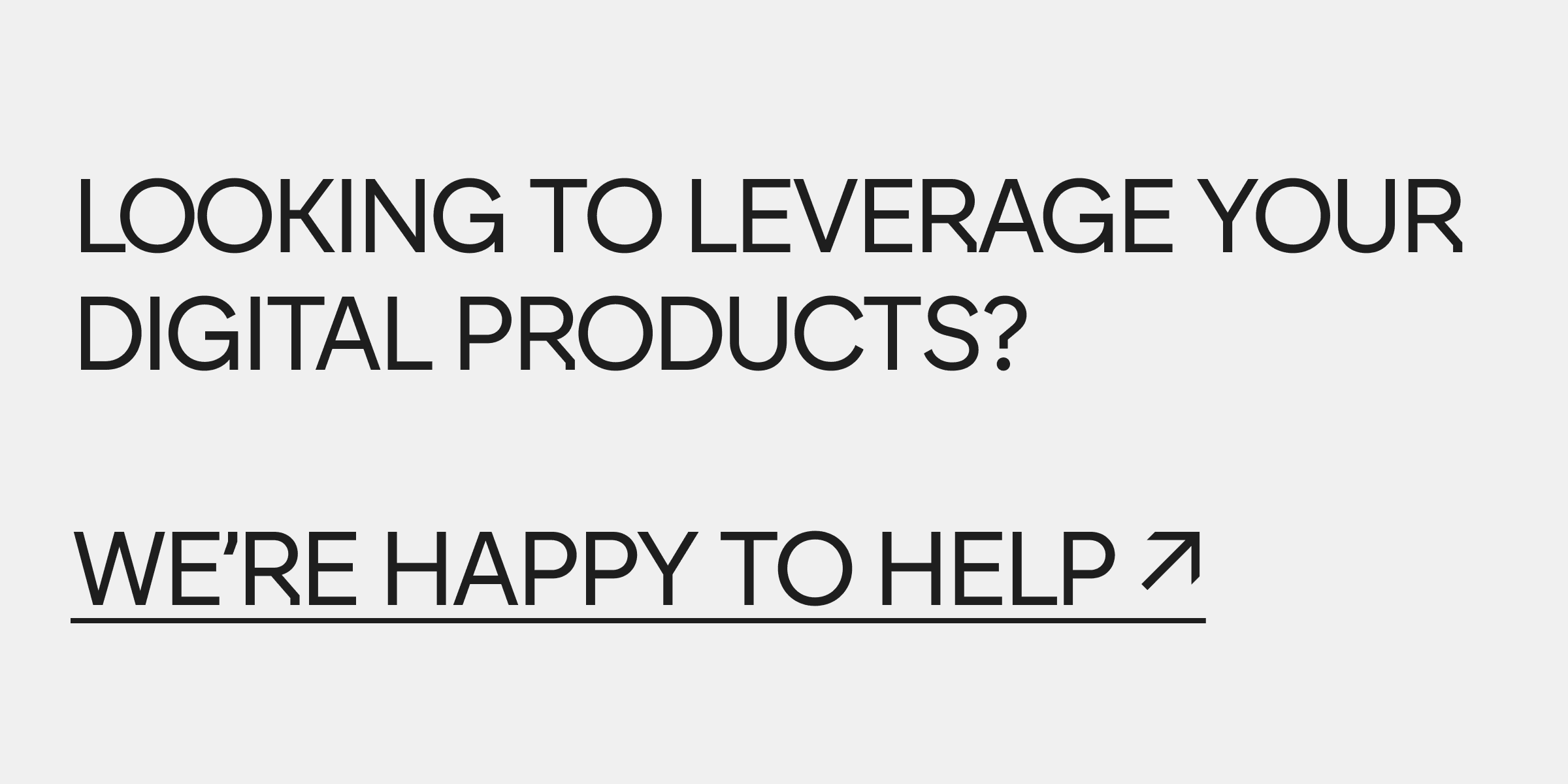

Strong Visuals and Graphics
Marketing materials are core of NGO website design. Strong visuals and graphics bring your mission to life, and the choice of materials you make decides on the impact your nonprofit website will have.
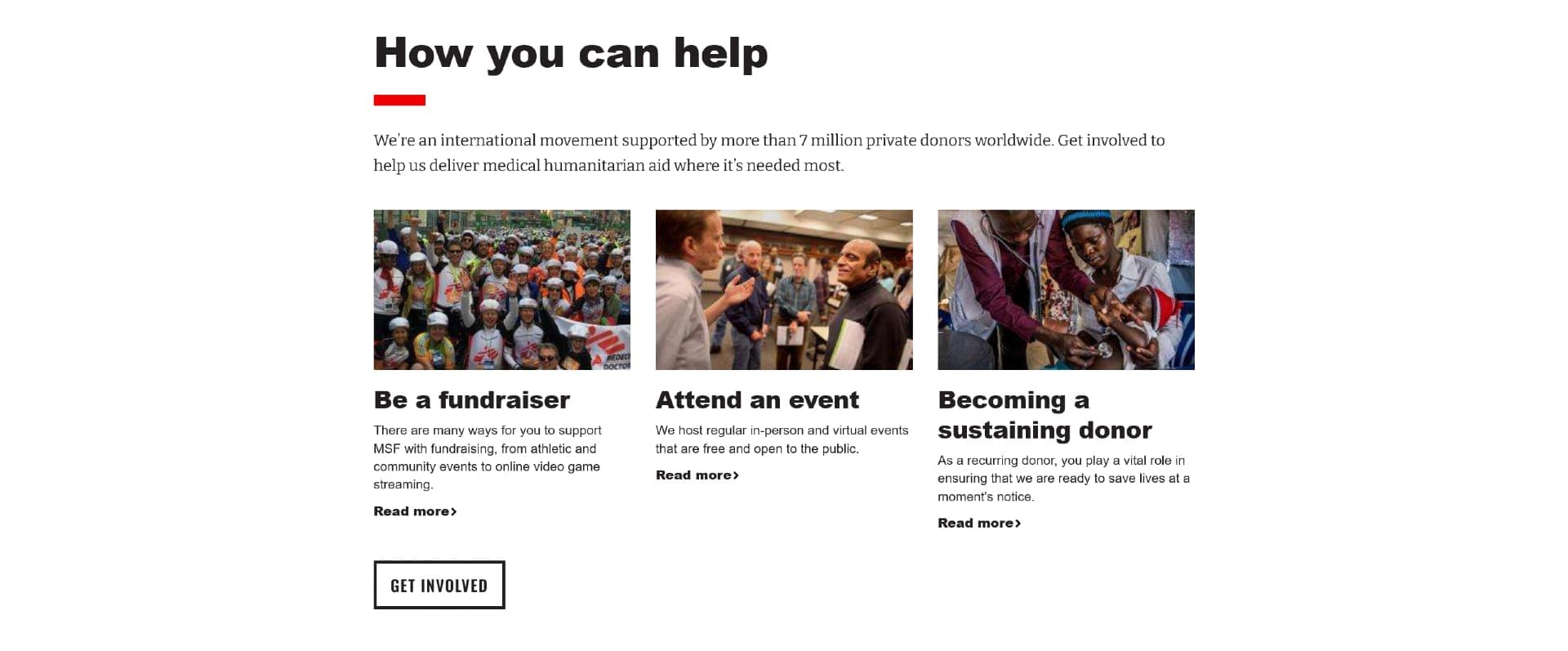
The section from Doctors Without Borders above makes a great use of that. The striking photos are meant to illustrate each option, but they do more than that. They show the support, community, and outcomes of their work. They complement the storytelling.
The reason they work so well is that they show unique images, likely taken by the organization itself. You can see real fundraisers, healthcare professionals, and people receiving help. Such high quality images add legitimacy to their success stories.
You should not forget about the rest of your nonprofit web design. Professional graphics can make it visually appealing, which will help draw users in and encourage exploration.
It is also a good idea to share helpful resources created by your nonprofit organization. Infographics are great for this – they are easy to save and share, and they can help raise awareness about your organization's mission.

User Experience and Accessibility
A seamless user experience (UX) lets visitors easily find the information they need and take action. This may seem rather obvious, however there is a lot that goes into making sure your nonprofit website is not overwhelming visitors. A well-structured website building process is key to ensure that all elements work together harmoniously.
There are many parts in web design that impact UX, such as intuitive navigation, clear calls-to-action (CTAs), and accessibility features. It all starts with simple and straightforward navigation. You don’t want your website users to wander around random web pages because they can’t find the prominent donate button, right? As a bonus, proper nonprofit website navigation helps SEO!
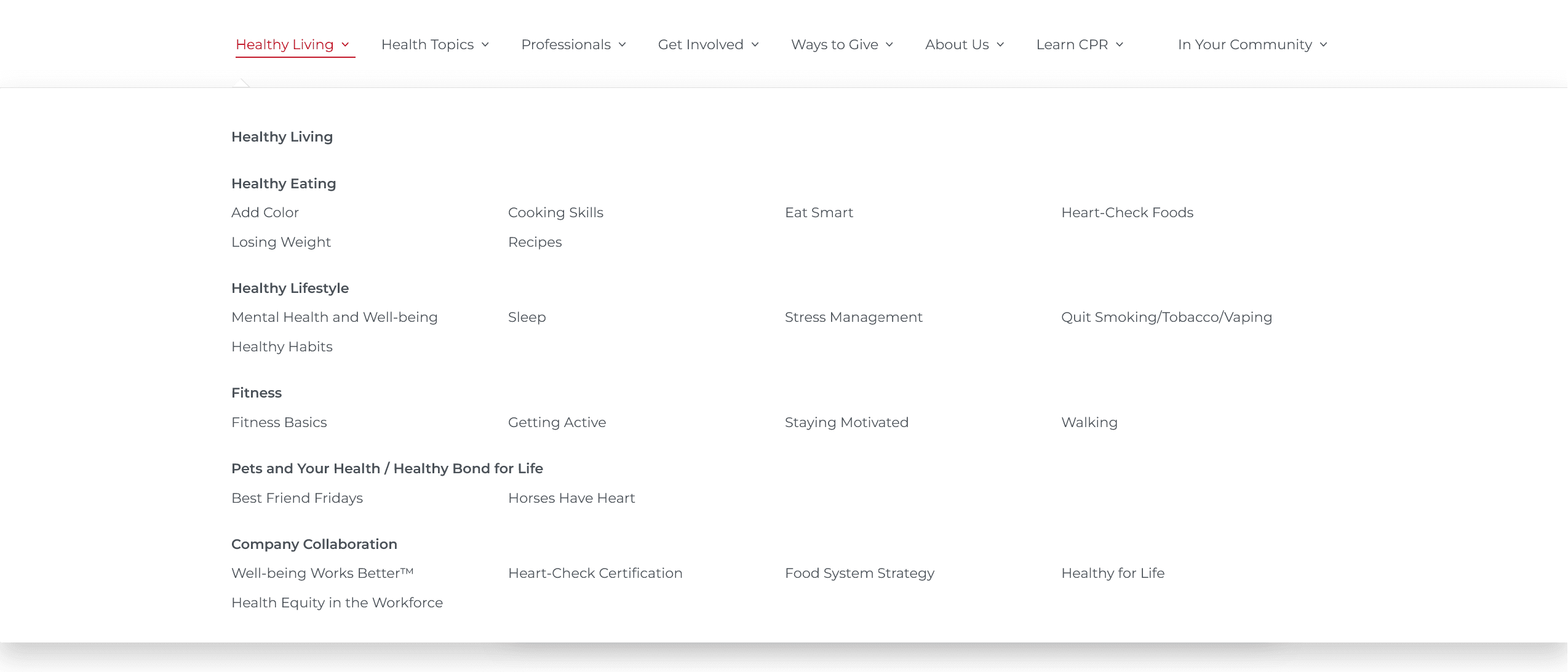
Let’s take a look at the American Heart Association. The navigation section looks very clean and simple. There are a few main menu positions, each expanding into a well-structured data hierarchy. What’s worth mentioning, the menu does not open on hover – rather a click – and stays on the whole time. It’s a minor tweak that makes it much easier for website visitors with special needs.
Many of the best nonprofit websites take pride in following high standards of accessibility in website design, such as ADA-compliant and WCAG 2.1, and AHA is no different. It claims that the entire website follows the A and AA levels of WCAG 2.1 accessibility guidelines. This means appropriate color contrasts, closed captions, alt texts for images, and many more.
Keep in mind that accessible web design is not just about people with disabilities. It’s likely that your website will attract visitors of all ages and background, so your web design should reflect that.
Read also: A Guide to Interface Design for Older Adults
Mobile-Friendly Design
It's been years since mobile devices overtook desktop in global traffic, and the gap is still growing. Semrush shows that in 2023 there were 313% more visits on mobile compared to desktop. It's safe to guess that a good chunk of your nonprofit website visitors scroll it on their phones. So, mobile-friendly web design is a must!
A well-designed website should be easy to use and navigate, with a clear and concise content strategy. World Wildlife Fund is a good example here. Although its website design falls into the more minimalistic category, it checks all the boxes of a mobile-friendly nonprofit website.
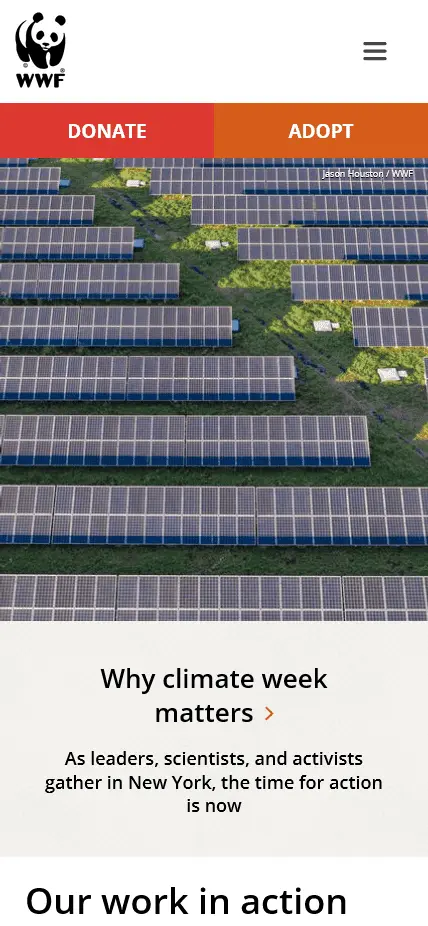
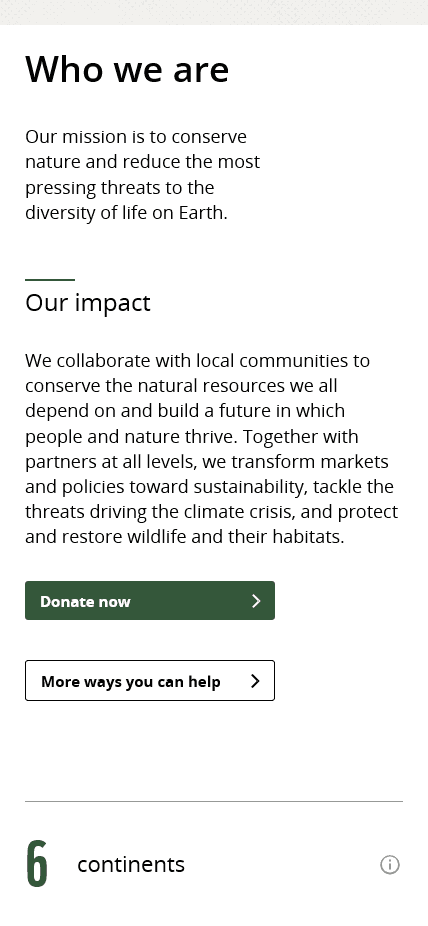
It is responsive, it has correct readability, it loads quickly, and it encourages visitors to engage by providing many ways they can help – with separate adoption and donation page versions for mobile users.
Streamlined Donation Page
Speaking of donation pages, they can be optimized, too. A streamlined donation page should have no unnecessary content that can distract prospective donors. They've already done their research, so there's no need to remind them with the nonprofit's mission and story. What it should do is:
Offer multiple donation methods – similar to e-commerce stores, the NGO donation page should offer varied ways of donating, including preset and custom amounts and multiple payment providers.
Offer recurring donations – an option for monthly or yearly recurring donations encourages long-term support.
Provide security assurance – security badges and policies in the donation form build trust among site visitors.
Include minimal form fields – only asking for essential information reduces friction in the donation process, thus increasing the success rate.
Show impact statements – information about how donations will be used and the impact they'll have on the cause confirms the visitor's choice.
Thank you page – a thoughtful thank you page that confirms the donation and suggests next steps for further engagement is a must.
Of course, the simpler the better. The donation form from RainbowYOUTH website is a great example of a modern form that blends well in the website's design.
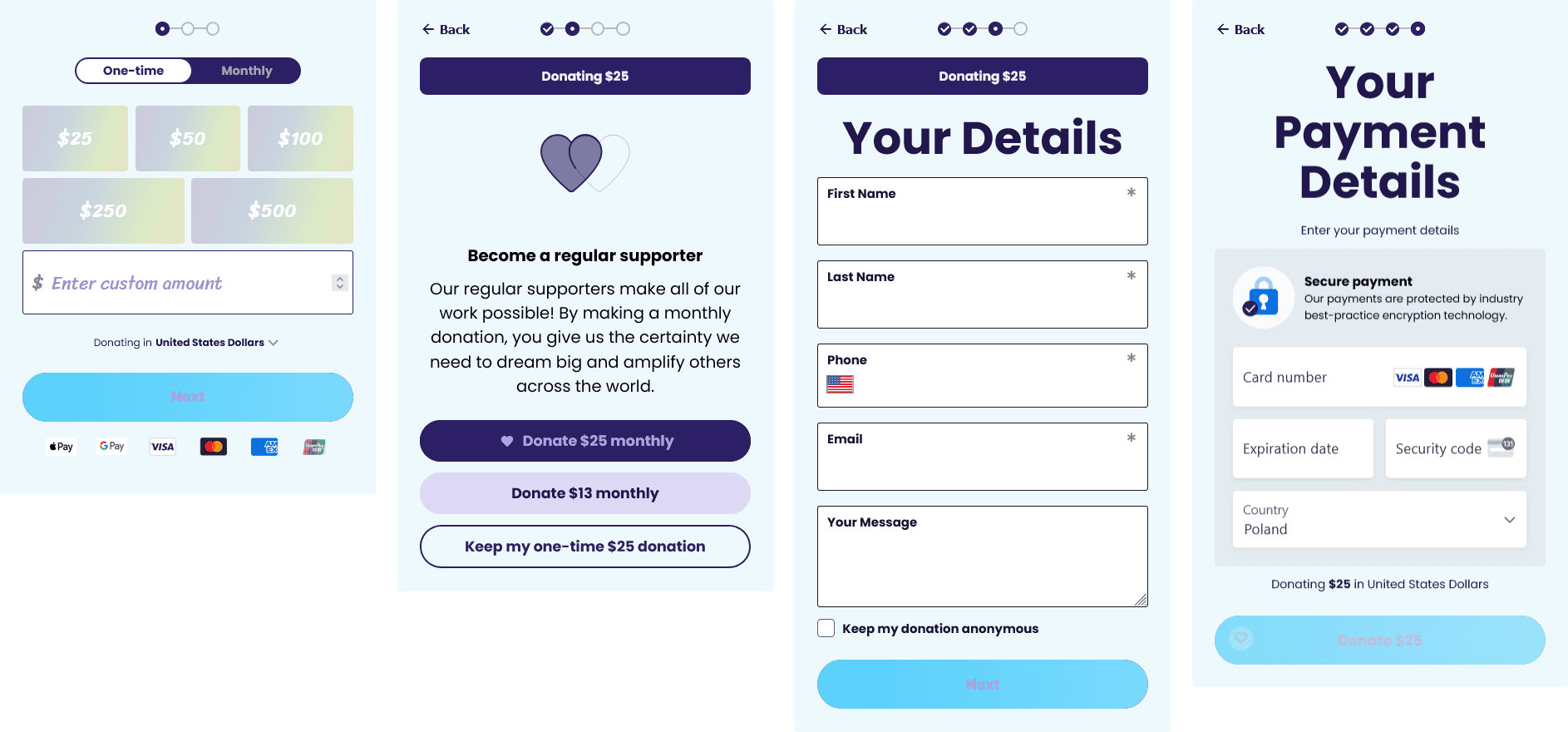
Social media has become an integral part of online communication for NGOs. While many organizations focus their efforts on platforms like Facebook or Instagram, integrating social media with your website can significantly boost your online presence and engagement.
Effective social media integration goes beyond simply adding profile links to your website. It involves creating a seamless connection between your website and social platforms, allowing visitors to interact with your content across multiple channels.
One way to achieve this is by embedding social media feeds directly on your website. This approach keeps your content fresh and encourages visitors to engage with your latest updates. The Ocean Cleanup's website is a prime example of this strategy. Their homepage features their most recent posts on their website and their social media.
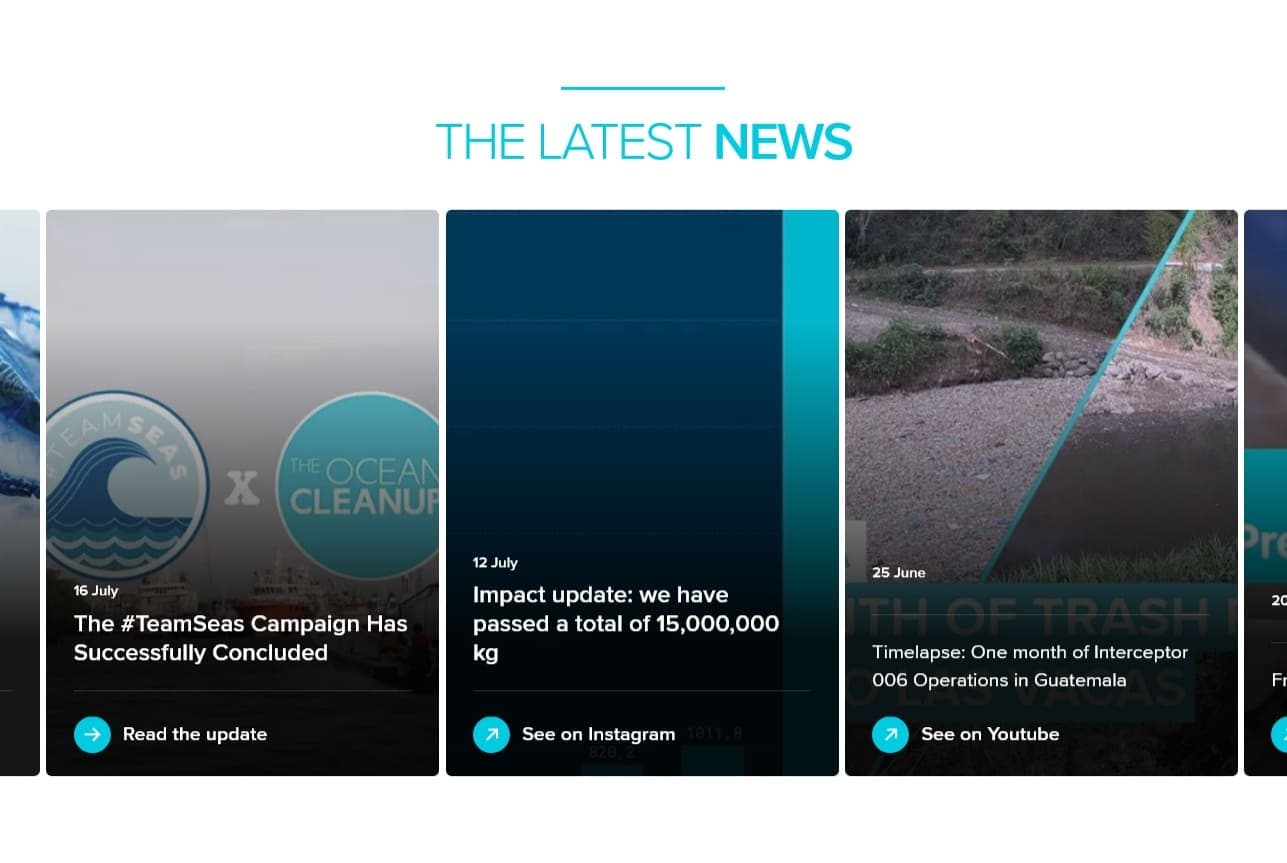
Another crucial aspect of social media integration is making it easy for supporters to share your content. By adding social sharing buttons to key pages, such as blog posts or donation appeals, you empower visitors to spread your message across their networks. This not only increases your reach but also adds a layer of social proof to your cause.
Transparency and Accountability
Trust is the cornerstone of any successful NGO, and their websites is central hubs for building and maintaining that trust.
Financial transparency is crucial. Many top nonprofit websites have a dedicated "Financials" section where visitors can access annual reports, tax documents, and breakdowns of spending. Charity: Water does this exceptionally well, providing audited financial statements and clear visualizations of their impact.
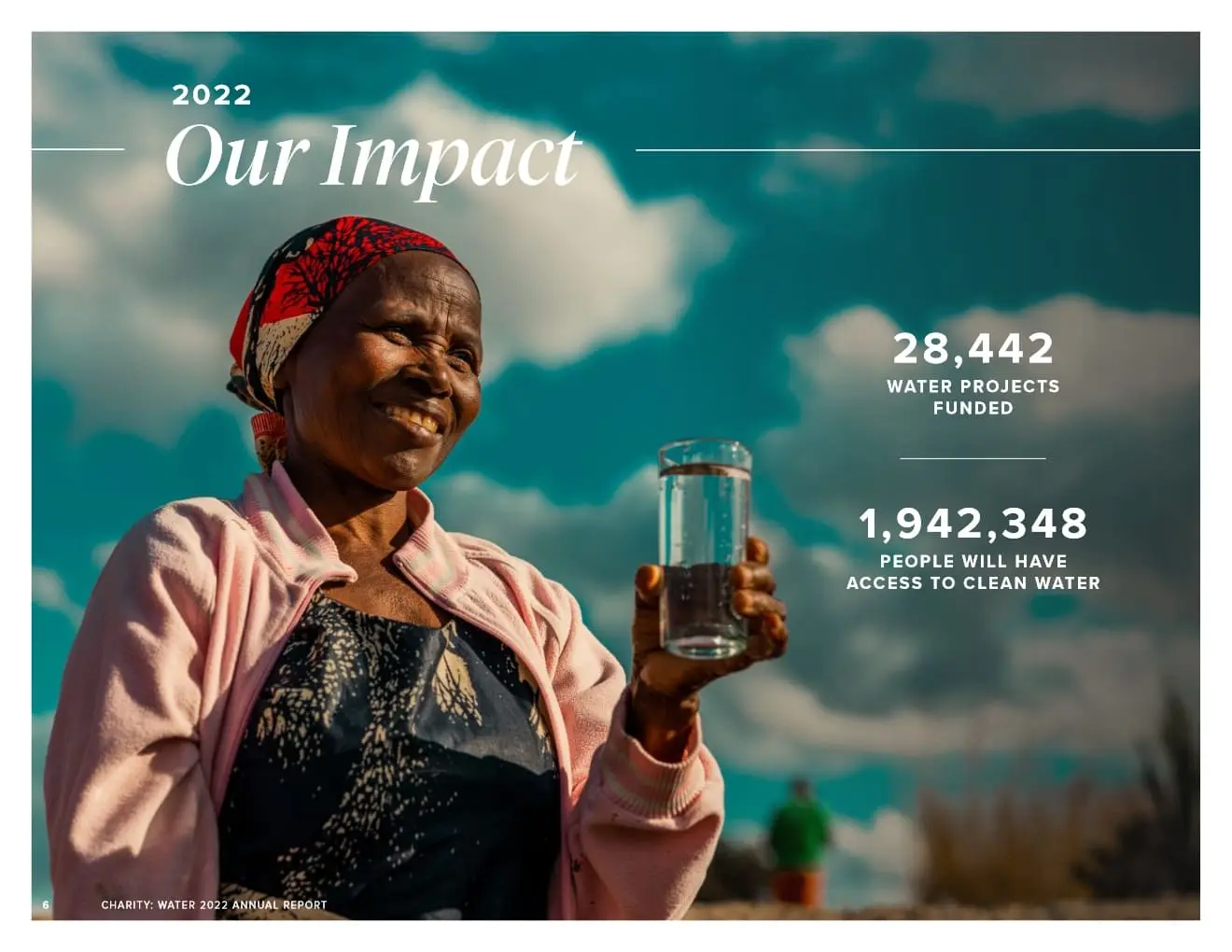
Beyond the numbers, the nonprofit website can tell the story of the organization's real-world impact. Interactive maps, case studies, and infographics all can be used to illustrate how donations translate to tangible results.

Introducing your team is another powerful way to build trust. Photos and bios of leadership and key staff humanizes your organization. Same goes for third-party validations, like awards or certifications. Prominent displays of these accolades show your practices are recognized by respected authorities.
Lastly, NGOs should be transparent about their data privacy policies. Clearly explaining how they handle and protect donor information can assure supporters that their personal data is secure. This level of openness reinforces an organization's commitment to ethical operations and responsible stewardship of resources.

Search Engine Optimization (SEO)
SEO for NGOs centers on two key aspects: visibility and credibility. When someone searches for information related to your cause, your organization should appear among the top results. There isn’t a surefire way to land among top nonprofit websites in Google search results, but there are certain actions nonprofit organizations can take to support that, among others.
SEO Best Practices for NGO Website
There isn't a surefire way to land among top nonprofit websites in Google search results, but there are certain actions nonprofit organizations can take to support that, among others:
Conduct keyword research – keywords are still among the top ranking factors for search engines, so using the right set can greatly increase the NGO’s chances of being seen. Useful articles, infographics, videos, and other types of content that visitors and search robots like can do wonders to the nonprofit website’s position.
Optimize the website – page layouts, speed, links… they all work towards the ranking position. A solid content strategy is one thing, but without a sound website it may not achieve the expected results. The good news are that almost every website builder has the tools needed to take care of it. Built-in SEO features within a CMS, such as meta titles, meta descriptions, and customizable URLs, are essential for optimizing the website and improving its visibility.
Build local visibility – location-specific pages, Google Business Profile, local citations, or even embedding maps are encouraging visitors from local communities to support your cause in their preferred area. This can boost the local NGO website’s visibility over nation-wide or global organizations
Follow Google guidelines – Google’s EEAT is a good example of guidelines to implement in your SEO strategy. It focuses on signals that build authority and trustworthiness of a website, and with it, the nonprofit organization behind it.
The Importance of an SEO Maintenance
SEO is not set-and-forget, but to a large degree it connects with other works you do on your website. So, regular SEO maintenance should not take that much effort – especially considering some agencies offering NGO graphic design services can also take care of content and technical SEO.
NGO Website Design Best Practices
Content Management System (CMS)
WordPress stands out as the ideal content management system (CMS) for NGOs seeking to manage and update their websites efficiently. Its user-friendly interface allows team members - regardless of technical skill - to create, edit, and publish content easily. This simplicity not only keeps your site current and engaging but also frees up valuable time and resources that can be redirected toward your mission.
In comparison to other CMS platforms like Joomla or Drupal, WordPress excels due to its extensive plugin library and customizable themes. These features enable NGOs to tailor their websites to specific needs without the complexity or steep learning curve often associated with more intricate systems. Whether you're looking to build an interactive donation page or a vibrant community forum, WordPress offers the flexibility and scalability required for organizations of any size.
By choosing WordPress, your NGO can streamline its website management process and ensure that your digital presence remains dynamic and relevant - helping you connect with your audience more effectively and amplify your impact.
Organization’s Branding
An NGO’s branding plays a pivotal role in establishing its identity and credibility online. A well-designed logo, cohesive color scheme, and consistent typography can create a unified visual identity that resonates across your website and social media platforms.
Developing a style guide is an excellent way to ensure consistency in branding across all online platforms. This guide should outline the specific colors, fonts, and design elements that represent your organization, providing a reference for anyone creating content for your NGO.
A strong brand identity helps build trust and recognition among your audience. When visitors see a consistent and professional presentation, they are more likely to perceive your organization as credible and reliable. This consistency also enhances the overall user experience, making your website more memorable and encouraging repeat visits.
Design Process for NGOs
Before you start designing your NGO website, you need to assess your organisation. Knowing these fundamentals will guide the design process and ensure the end product communicates your message.
Start by identifying your target audience, mission and values. Knowing who you are trying to reach and what you want to say will help shape the content and design. Next, determine the key performance indicators (KPIs) that will measure the success of the website, such as visitor engagement, donation rates or volunteer sign ups.
Doing a competitor analysis will give you valuable insights into the online landscape and opportunities for differentiation. By looking at other non-profits in your space you can see website design best practices and where your website can stand out.
Finally, develop a unique value proposition (UVP) that clearly states your NGO’s mission and purpose. This UVP should be front and centre on your website so visitors can quickly see what sets your organisation apart and why they should support your cause.
By assessing your organisation you can have a website that looks good and drives real engagement and supports your mission.
How To Choose the Best NGO Web Design Agency?
Nonprofits need a web design team that understands both the constraints and goals unique to their sector. This boils down to understanding the balance between communicating a mission and maintaining cost-effectiveness.
To achieve success, agencies that want to work with NGOs have to adjust their approach to not just create best looking websites, but rather ones that resonate with the prospective donors. The ideal agency should show a genuine interest in the NGO's cause and demonstrate an understanding of the organization's goals and values.
The NGO web design agency should also know how to work with different communication channels. The nonprofit website is just a part of raising awareness online. Having one agency support, for instance, SEO, social media, and newsletters can save some time and money.
Most NGOs value transparency, and this should extend to the agencies that partner with them. Clear communication about budgeting and operational processes is essential. Both the NGO and agency need to align expectations and maintain an open dialogue about goals and challenges – just like good business partners.
Here is more: How To Choose a Web Design Agency?
Why Choose Adchitects for Your NGO Website Design?
What team do you need? is a question we often ask our clients early in the discovery phase. The answers we get often reveal the unique needs and goals of each organization. At Adchitects, we prioritize understanding the specific requirements of your NGO project to assemble a team that aligns with your vision. This means:
- Experienced professionals – our teams bring diverse skill sets, from core web design to project management and SEO. You can rest assured that the project is in good hands.
- Transparency and collaboration – we stand by open communication throughout the entire process. This approach fosters trust and keeps everyone on the same page, ensuring that your feedback is valued and incorporated at every stage.
- Custom solutions – we understand that no two NGOs are the same. Our team works closely with you to develop tailored strategies that address your specific challenges and objectives. All that in affordable, friendly, and approachable manner.
- Commitment to impact – our focus extends beyond just delivering a finished product. We aim to create solutions that enhance your NGO’s mission and help you make a meaningful difference in your community.
By choosing us, you gain more than just a service provider. You gain a partner committed to advancing your mission. Our focus on innovative solutions ensures that your NGO not only meets its objectives but also thrives in a competitive landscape.
Examples of Our Best Nonprofit Websites
At Adchitects, we showcase a portfolio of successful projects that highlight our capabilities and creativity. Each project demonstrates our commitment to producing user-friendly, visually appealing, functional and accessible designs.
The Explorers Club
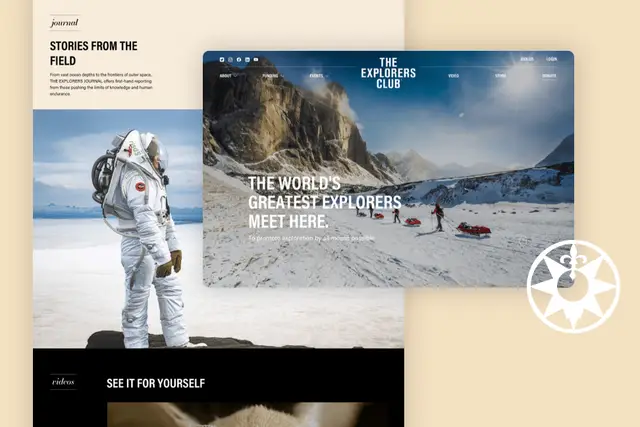
The Explorers Club aimed to refresh its online presence to better connect its community of scientists and scholars. We created a website that allows members to engage with one another and stay updated on events and activities. The new site features historical imagery, a calendar, an events page, a members' area, and a travel map, all designed to align with the club’s unique branding.
The website highlights the club's rich history and the accomplishments of its distinguished members, including renowned explorers like Neil Armstrong and Sir Edmund Hillary. A custom calendar showcases various events, from lectures to exciting trips, while the history section shares over a century of exploration and discovery. An interactive map illustrates significant expeditions by club members, reinforcing the connection to the club’s legacy.
Designed with accessibility in mind, the site caters to members of all ages, ensuring everyone can participate fully. The thoughtful use of the club’s color schemes and typography reflects its values and mission. This project not only modernizes The Explorers Club’s digital presence but also strengthens its role as a community for exploration and education.
Read full case study how we helped TEC: Website for a Renowned Club of World-Class Explorers
The International Pediatric Nephrology Association
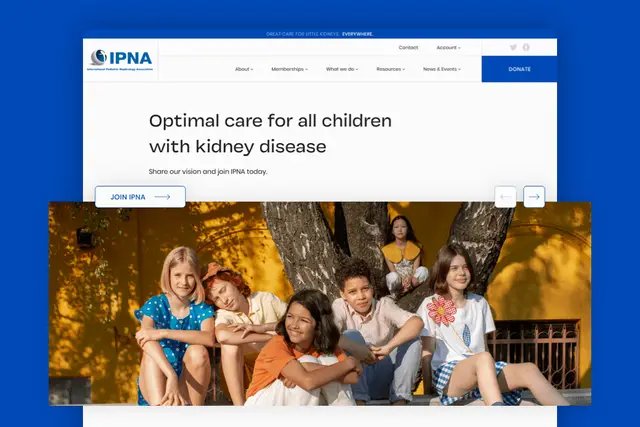
Having a reliable and user-friendly online source is crucial for pediatric nephrology professionals. The International Pediatric Nephrology Association is one of such, and we added our own touch to it. Our focus centered on accessibility, ensuring users of all abilities can easily navigate the site. We integrated features that prioritize user experience while maintaining an inviting and informative design.
The site presents a wealth of resources and educational materials tailored for healthcare professionals. With a clear layout and intuitive navigation, members can quickly find the information they need. This approach reinforces IPNA’s commitment to supporting those dedicated to pediatric kidney health.
Summing Up
The role of a well-designed website in the success of an NGO cannot be overstated. It serves as a critical tool for communication, fundraising, and community building. An engaging site that reflects the organization’s mission can attract and retain visitors – or potential donors. A well-structured website building process is essential to ensure the site is effective and user-friendly.
A well-designed NGO website increases legitimacy, and solidifies professionalism. It is not just about the looks, good NGO web design takes accessibility and unique needs into account. Selecting a design agency that understands those unique needs can help create a website that not only informs but also inspires action, ultimately leading to better future.

















